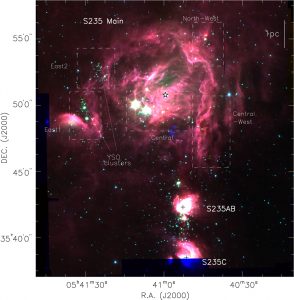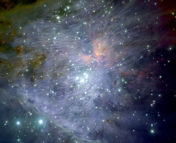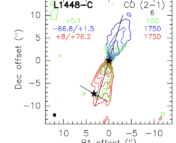Title: Magnetic fields and Star Formation around HII regions: The S235 complex
Authors: R. Devaraj, D. P. Clemens, L. K. Dewangan, A. Luna, T. P. Ray, J. Mackey
First Author’s Institution: Dublin Institute for Advanced Studies
Status: Published in The Astrophysical Journal, open access on arXiv
Massive young stars heat the interstellar material around them, creating HII regions, or areas full of ionized hydrogen. As the stars push stellar wind and UV radiation outward, their HII regions expand, and a balloon of interstellar material begins to collect around the central star. Surrounding gas and dust is swept up by the balloon, and the magnetic field changes.
Astronomers know that magnetic fields play an important role in star formation. And we also know that expanding HII regions can trigger star formation. But how the two fit together in the overall process of creating new stars remains mysterious. Today’s paper examines S235, a star-forming complex that is home to HII regions and young stellar objects, in order to explore how the magnetic field structure and strength affects star formation.
The Balloons In Star-Forming Complex S235
S235 contains three HII regions, which are labeled in Figure 1 as S235 Main, S235AB, and S235C. The star symbol shows the central ionizing star for S235 Main, while the crosses show the same for the smaller HII regions. Past studies have identified many young stellar objects (YSOs) in this field. The white dashed boxes show where clusters of those baby stars are located. Many of the YSOs are located right on the edge of the largest inflating, balloon-like HII region.

Figure 1. The S235 field of view in the infrared. There are three HII regions, which are seen as the pink, roughly circular structures. Each has a central ionizing star. Clusters of young stellar objects are traced in the white dashed rectangles. See Figure 1 in the paper.
Polarization Traces Inflation
The authors of today’s paper used polarimetry from the Mimir and POLICAN instruments to trace the magnetic field in this complex. Near infrared polarimetry measures the orientation of light from stars in the background. Egg-shaped dust grains in the interstellar medium will align their long axes perpendicular to magnetic fields. That means the dust blocks one orientation of light more than another. By measuring that orientation, we trace the magnetic field!
It’s important to make sure that the polarization measurements used in this study are actually behind the HII regions. Otherwise, they aren’t examining the magnetic field in the right place. The authors filtered out foreground stars using Gaia distances and constraints on the extinction, or amount of dust that must be present towards a star. They also threw out the polarization data from young stellar objects, which create their own polarization from their circumstellar disks.
In order to get rid of any foreground dust component, the authors subtracted the average polarization of the foreground stars from the stars in the background. That left them with the orange polarization vectors in Figure 2. The direction of the vectors traces the magnetic field, while their length shows the strength of the polarization. It’s pretty clear that for S235 Main, the magnetic field traces the outskirts of the HII region! That means the magnetic field is pushed and compressed as the HII balloon inflates.

Figure 2. Polarization measurements for stars behind the S235 complex. The vectors trace the magnetic field, which appears to follow the outskirts of the largest HII region bubble. See Figure 8 in the paper.
Clumpy Clouds Created Stars
Using maps of gas and dust intensity, today’s authors also identified 11 main clumps of interstellar material in the field of view. They measured the magnetic field strength in those clumps and found that the magnetic energy was dominant over both turbulence and gravity. The magnetic field is actually so important that it has slowed star formation, bringing it to a halt.
But the presence of YSOs means that star formation had to happen at some point in the past. The authors suggest a timeline of events: 1) Before the HII region expanded, the magnetic fields and gravity balanced out, creating an equilibrium. 2) As the HII region began to expand, it created dense regions and turbulence, which caused the gas and dust to collapse and stars to form. 3) The turbulence decayed and the magnetic field became more important. It started regulating and stopping star formation, leading the region to look how it does today.
This new understanding of how magnetic fields and HII regions are related is crucial to compiling an overall picture of star formation. But the overall process is complicated and involves so many moving parts that there is still much to be learned about how stars are born!
Astrobite edited by Ciara Johnson
Featured Image: NASA/JPL-Caltech/UCLA




